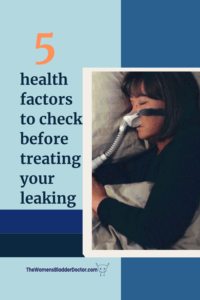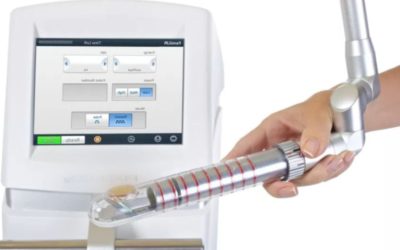Five health factors to check out before treating your leaking
Leaking. No one likes it. But so many of us have it. Don’t believe me? Global Market Insights calculated that 10.5 billion dollars were spent in 2020 on disposable incontinence products. 1 This number is estimated to increase to 17.4 billion in the next five years. The pelvic floor stimulator market (focused on treating incontinence) was 180 million dollars in 2020 and will more than double in the next five years. 2 That is a lot of women looking for help with their leaky bladders. This is more money than we spend nationally on mammograms or kidney stones.
To put it in perspective, the market for incontinence products is about the same as the market for lipstick. This is amazing! I see lipstick everywhere and know most women own it. But incontinence products are still discretely hidden away, even though many of us own them. Lipstick is something you can just pick up at the store. Unlike lipstick, there are a few things to consider before you buy something to treat your bladder leaking.
What health factors need to be checked out before treating your leaking?
The first line of treatment for incontinence is muscle strengthening.
There is universal agreement on this.3 This is what providers recommend, and many women want to do this on their own. We used to believe that pelvic floor strengthening had to be done with a specialized physical therapist. And while this is very effective (and maybe even the most effective), there is growing evidence to show that strengthening on your own can also work.4-7
Once your muscles are strong, there are different treatment strategies for stress incontinence and urgency incontinence.
Stress incontinence strategies focus on engaging and squeezing the muscles before the activity that makes you leak (commonly called the knack). Urge incontinence strategies focus on urge suppression which stops the bladder muscle from contracting when you don’t want it to. It is not hard to learn to strengthen the muscles but incorporating these strategies into your daily life can be a challenge. A good physical therapist can be the guide to get you through this challenge.
But before you get to these strategies, you need to ensure that nothing else is going on. While incontinence is commonly caused by muscle dysfunction or weakening of the supportive tissues, there are other medical issues to consider. Jessica McKinney3 put together this infographic to help demonstrate this information and promote conversations between providers and patients. She did an amazing job of presenting this information. It is especially helpful if you are a visual learner.
But here are the big issues to consider before you try to self-treat your incontinence:
1) Are you up to date on routine medical care and screening?
This may sound obvious, but it is important. There are lots of conditions that can cause a discharge that may be easily mistaken for incontinence. I have seen many women who have had cancer or an untreated infection that was confused for bladder leaking.
There can also be structural issues that can lead to leaking. We see fistulas (which is a hole in the bladder leading to another part of the body) and urethral diverticulae (a small pocket that comes off of the urethra and drains urine unexpectedly), and prolapse (a herniation of the vagina that can impact bladder function). All of these anatomical changes can lead to leaking.
Skin and vaginal changes that are secondary to hormonal changes can also impact your bladder. And these hormonal changes can be secondary to birth control, pregnancy, medication, or menopause.
This list of things may seem overwhelming to you. It is just to point out that there are factors that can contribute to leaking that you have not thought about. So, it is key to ensure that you have a normal PAP smear and no bumps, lumps, or masses that you don’t know about. This means a pelvic exam. I know this is no one’s favorite, but it is a critical screening tool. Someone has to look and make sure your system is functioning correctly.
2) Do you have a medical condition that may be causing bladder symptoms (diagnosed or not)?
This happens frequently! Many common medical conditions can impact the bladder even if it does not seem like they should. Diabetes can cause urgency, frequency, and leaking.
Untreated sleep apnea can make you pee more at night. This can lead to waking up frequently to empty or leaking at night. Back problems and back pain can worsen bladder leaking. Neurologic conditions like multiple sclerosis (MS) can wreak havoc on the bladder. MS can make it hard to empty when you want to empty and cause you to leak urine while trying to stay dry. That is hardly fair!
These are important medical conditions that I consider. When I meet a new patient But your primary care provider also screens for these issues. Strengthening your pelvic floor won’t work if one of these medical conditions is causing your bladder to act up.
3) Are you taking any medications or supplements that may impact your bladder?
Most of what we put in our mouths can impact the bladder. Your bladder is sensitive. Everything we consume is processed through either the kidneys or the liver (or both).
If it is processed through the kidneys, it can impact the bladder. This means that there are so many things that can upset it! Medications, supplements, foods, carbonation, additives……this is another important factor in assessing your bladder.
One of the easiest ways to assess whether a medication or supplement is affecting your bladder is to think about timing. Did you develop bladder symptoms when you started the treatment? Or increased the dose? Again, these are all things that I assess in the office.
4) Do you empty your bladder well?
This is important and not something that most women think about. If your nerves and system work well, you will empty well and know it. But if your nerve function or sensation is poor, you may have trouble emptying and not know it.
There are medical conditions that can do this. There are medications that can do this. It can happen after a delivery. It can happen after anesthesia. Urogynecologists always check this in the office. This is not a screening test that most other providers perform (although they will generally check if there is any indication).
This is easily checked by having you empty and then doing an ultrasound to ensure you are empty. If there is no ultrasound, it can be done with a catheterization. Emptying poorly is less common than the other factors listed here. If you start your own strengthening program without evaluating this, remember to get it assessed if the strengthening does not work.
5) Do you have blood in your urine?
It isn’t normal to have blood in your urine.
And while some women do have a small amount of blood in the urine, it should always be assessed by a clinician.
Blood in the urine can be a sign of a kidney or bladder stone, even if there is no pain. Removing the stone may improve the leaking. It can be a sign of a tumor or cancer.
Bladder cancer can also cause peeing frequently and leaking. Some bladder infections can cause bleeding. Less common issues like a foreign body or endometriosis can also cause bleeding. The blood may be visible (you should always tell your doctor if you can see blood in your urine) or microscopic.
When we screen for blood in the urine, we also look for microscopic amounts of blood. This means we need a urine sample, and we can perform a urinalysis in the office or look at it under the microscope.
So before you embrace a pelvic floor strengthening program, make sure you are up to date on your health care!
You should be current on your pelvic exam and PAP smear and have had a normal urinalysis (no blood) and the normal screening lab tests (they vary based on your age).
Routinely seeing a health care provider will screen for many of these issues. You need to be evaluated if you have any odd symptoms, even if they don’t seem related to your bladder.
This might include visual changes, numbness, and tingling in an arm or leg, frequent urinary tract infections, visible blood in the urine, etc. Really, anything that seems odd to you.
And if you try strengthening on your own, stick to your routine like a boss for three months, and don’t have any improvement in your bladder symptoms, you need to see a provider. This provider will review your medical history and symptoms, examine you and make sure you don’t have any additional issues that need to be treated. And then they can help you figure out what else can be done to help your leaking! Many women start treating their leaking on their own but may need some help to reach their treatment goals!

2.https://www.polarismarketresearch.com/industry-analysis/pelvic-floor-electric-stimulator-market
- McKinne JL.J Women’s Health. 2022.
- Dumoulin C Jama Intern Med 2020
5.Wu C Int Urogyne J 2020
6. Barnes KL Female Pelvic Med Reconstruct Surg 2021
7.Bernard S Int Urogyne J 2020





0 Comments